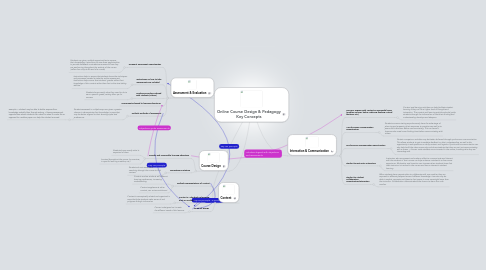
1. Content
1.1. Multiple representations of content
1.1.1. Content reaches students will different learning preferences, increasing understanding
1.1.2. Content supplements other content, can act as enrichment
1.2. Content is "chunked" in learning units or modules
1.2.1. Content is conceptually related and organized in ways that help students make sense of and progress through information
1.3. Universal Design
1.3.1. Course is designed so it meets the different needs of the learners
2. Course Design
2.1. Specific and measurable learning objectives
2.1.1. Students know exactly what is expected of them
2.1.2. Located throughout the course (in overview, in specific learning modules, etc.)
2.2. Navigation is intuitive
2.2.1. Students do not waste time searching through the course to find content
3. Assessment & Evaluation
3.1. Frequent assessment opportunities
3.1.1. Students are given multiple opportunities to express their knowledge. Instructors can use these opportunities to provide feedback so students are aware of how they are performing throughout the entirety of the course (rather than only at the end of a course)
3.2. Instructions on how to take assessments are included
3.2.1. Instructions help to ensure that students know the techniques and processes needed to take the online assessment. Instructions help ensure that students' grades reflect their knowledge of the content rather than their online test-taking abilities
3.3. Grading procedures shared with students (rubrics)
3.3.1. Students know exactly what they need to do to earn a specific grade, setting them up for success
3.4. Assessments aligned to learning objectives
3.5. Multiple methods of assessment
3.5.1. Students assessed in multiple ways are given a greater chance to demonstrate their knowledge in ways that may be better aligned to their learning styles and preferences
3.5.1.1. Example: A student may be able to better express their knowledge verbally than through writing. Allowing assessment opportunities where students can submit a video or audio file as opposed to a written paper can help this student succeed.
4. Interaction & Communication
4.1. Learners engage with content in meaningful ways (problem solving, higher ordering thinking, critical thinking, etc.)
4.1.1. Content and learning activities can help facilitate student learning if they call for a higher level of thought and interaction. The content and learning activities should guide students through the information so that their thinking and understanding develops and deepens
4.2. Asynchronous communication opportunities
4.2.1. Students communicating asynchronously have the advantage of planning and preparing their responses to questions as well as to peers and instructors before communicating. This can benefit learners who need more thinking time before communicating with others
4.3. Synchronous communication opportunities
4.3.1. Certain concepts or activities may be better delivered through synchronous communication. This allows students to get immediate feedback on their understanding, as well as the opportunity to ask questions or clarify content and logistics. Synchronous communication can also help build the class community and show students that they are not just communicating with a screen -- this can make students more invested in the course, knowing who they are interacting with
4.4. Student to instructor interaction
4.4.1. Instructors who are present and make an effort to communicate and interact with the students in their course can help enhance a student's online course experience. Motivation and incentive can increase when students know that their instructor is involved in the course and has an interest in student learning
4.5. Student to Student Collaboration opportunities/interaction
4.5.1. When students have opportunities to collaborate with one another, they are exposed to different perspectives and different knowledge. Learners may be able to explain concepts and ideas to their peers in more meaningful ways than the instructor. Collaboration allows students the chance to learn from one another
